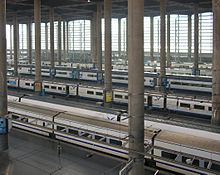Madrid Atocha train station
The Atocha train station (official name by ADIF : Madrid Puerta de Atocha ) is one of the two train stations in Madrid . In contrast to the Chamartín North Train Station , Atocha is located in the center of the city, at the Plaza Emperador Carlos V, not far from the Botanical Gardens and the Museo del Prado . In addition to the long-distance and high-speed trains from southern Spain and the regional trains, all S-Bahn lines ( Cercanías ) in the region and line 1 of the Madrid Metro stop in Atocha . This makes Atocha one of the most important transport hubs in the metropolis with its 3.5 million inhabitants.
Atocha was created as a terminus . The old station concourse is famous for its large cast iron and glass roof structure , which was built between 1888 and 1892 in Art Nouveau style by the architect Alberto de Palacio y Elissague from the Basque Country . Since the new train station (architect José Rafael Moneo ) went into operation south of it in 1992 , there has been a tropical palm garden under the huge vault of the old station hall, which is used as a waiting hall and meeting point.
Today's train station consists of two parts. The long-distance trains, including the AVE high-speed train to Seville , end in the above-ground section of the station, which is again built as a terminal station. Regional trains and S-Bahn trains use an underground through station, which is followed by three double-track tunnels. The middle tunnel runs from south to north, largely along the main urban axis Paseo del Prado-Paseo de Recoletos-Paseo de la Castellana through the city to Chamartín train station. In Madrid, this tunnel is often referred to as the “ Túnel de la risa ” (Tunnel of Laughter), which is due to its 34-year planning and construction period. The name was also transferred to the other two tubes: the western tunnel, which was inaugurated in 2008 and leads to Chamartín via Puerta del Sol and Nuevos Ministerios , and the shell of the standard-gauge eastern tunnel for the AVE high-speed trains, which was completed in 2011 and is still used today ( Status: 2017) is not yet usable.
On March 11, 2004, during the morning rush hour, the station was the scene of the Madrid train attacks .
Web links
Coordinates: 40 ° 24 ′ 26 " N , 3 ° 41 ′ 30" W.

